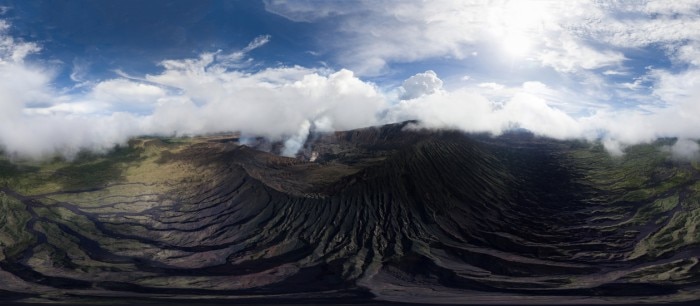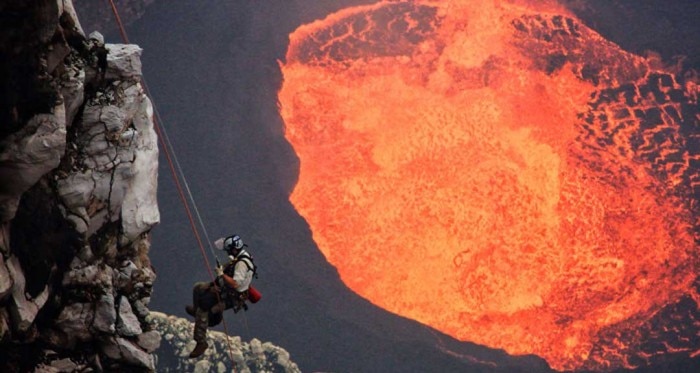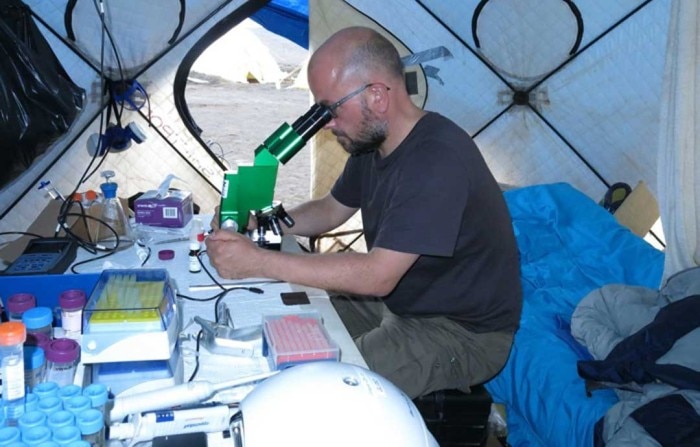-
- Benchtop Centrifuges
- Floor-Standing Centrifuges
- Refrigerated Centrifuges
- Microcentrifuges
- Multipurpose Centrifuges
- High-Speed Centrifuges
- Ultracentrifuges
- Concentrator
- High-Speed and Ultracentrifugation Consumables
- Accessories
- Tubes
- Plates
- Device Management Software
- Sample and Information Management
- IVD Products

Quest for Life in the Most Hostile Environment
Jens Oliver Bonnet Lab Academy
- Pharma
- Biotechnology
- Nature
- Health & Medicine
- Lab Life
- Lab Routine
- Pipetting & Dispensing
- Efficiency
- Ergonomics
- Accuracy
- Dispensers
- Pipettes
- Essay
The Marum crater with its 1,100 °C hot lava lake on the volcanic island of Ambrym belongs to the island nation of Vanuatu in the South Pacific - and is certainly one of the most hostile places on our planet. It's hard to imagine that any life form could survive in this environment, next to the bubbling lava from which red-hot fountains are spewed again and again. But to be absolutely sure, a closer look has to be taken. And that's exactly what Jens Kallmeyer did. With his colleague Jeffrey Marlow from Harvard University, the geomicrobiologist ventured down into the volcanic crater and its 400-meter-high walls bathed in toxic gases. At the bottom of the crater, he dressed in a heat protection suit and gas mask and approached the lava lake to retrieve samples.
He is leading the Group for Aquatic Geochemistry of the Section Geomicrobiology at the Helmholtz Centre Potsdam , GFZ German Research Centre for Geosciences. “We are interested in interactions between the biosphere and the geosphere, so we look everywhere where conditions allow for life to persist. This can be close to Earth’s surface like in soils or deep underground, which is one of my main research topics.” The questions addressed are equally diverse, ranging from pure basic research, for example understanding specific adaptations of microbes to certain conditions, to very applied topics like managing microbial activity in geothermal reservoirs or assessing the risk of microbially induced corrosion in radioactive storage facilities.
Read more
Read less

Using a wide suite of techniques, Kallmeyer, Marlow and their teams were able to show that there is abundant microbial life, but the organisms live in carefully selected niches and use very different survival strategies, all within a few millimeters.
Read more
Read less

Other thrilling field trips
“Nothing beats an active volcano”, Kallmeyer admits. “However, I’ve been to many other places off the beaten track.” Lake Towuti on Sulawesi Island in Indonesia, for example. This lake is located literally in the middle of the jungle, more than 1.000 km from the next airport. Sampling there was challenging as well, but quite different from being on top of a volcano, Kallmeyer explains. “The volcano expedition was done just my colleague and myself while our work was limited by the equipment we could bring to the field site.” The Lake Towuti expedition was much larger in scale: “We carried out a deep drilling campaign in the lake and had to transport dozens of containers and many tons of equipment plus a team of about 20 people to and from the lake. So, every expedition is different and comes with its own challenges .”
Read more
Read less

Liquid handling as the usual option in the field
Whenever precise analyses are required on an expedition, the list of feasible methods is very short. “Liquid handling is often the only appropriate handling in the field”, clarifies Kallmeyer. “A precision scale needs recalibration once it is moved. And more commonly, there is no way to properly set up a balance. A pipette is much more convenient, it keeps its calibration during transport and is much easier to pack. And in my experience the accuracy of normal pipettes is sufficient in the field.” If possible, the scientists carry solutions with them, or pre-weighed reagents to which they just add water.
Special challenges in the field of liquid handling
Lab work that requires delicate work like pipetting is not done in harsh environments, assures Kallmeyer: “If conditions become extreme, then operations are reduced to just sampling. In a heat protection suit, there is no way to operate anything more sensitive than a hammer and standing next to a 1.100°C hot lava lake, you will not even think about pipetting.” So, in general, all analyses are performed in environments much less challenging and there is a significant distinction between sampling, sample processing and sample analysis. “During field work accuracy is important, but perhaps not to the same degree as in the lab. We have to balance between the accuracy that possible in the field vs. how much time it takes to achieve this level, given the limited time available during a field trip. Thus, we try to avoid any measurements that are so sensitive that temperature or density fluctuations would bias the results.” On a field trip, Kallmeyer usually relies on air cushion pipettes . “In the home lab we use positive displacement pipettes for very small volumes , but I try to avoid doing such work in the field. The possibility for errors is just too big.”
What really matters when it comes to equipment
When planning a field trip, every single step of sampling, sample processing and sample analysis is carefully dissected into small increments and written down. “We define what tools and reagents are necessary for each step and how much you need for the number of samples or analyses planned, plus a safety margin”, explains Kallmeyer. “Reliability of the equipment, e.g., pipettes, is perhaps the most important point. In most cases re-calibration is not possible, so I have to be able to trust the results.” Resilience is another must have, as field equipment needs to withstand extreme conditions. “But luckily, most equipment is surprisingly robust.” And last but not least: Ergonomics . “There simply is no time for fiddling around. Thus, complicated use is usually the death sentence for any type of field equipment.” As many analyses have to be conducted in the home lab, transporting samples safely is always an issue. “For molecular biology we try to freeze the sample tubes as quickly and cold as possible, liquid nitrogen being the best option. But in many cases oxygen is our worst enemy, so storage must be in a protective atmosphere. We usually take gas-tight foil sleeves that we can heat-seal and flush with Nitrogen or any other inert gas.”
Read more
Read less

What needs to be done in advance depends on the destination, the number of people taking part and the scope of an expedition. For some destinations the permitting process alone might take many months and logistics can also be quite a challenge, Kallmeyer concludes: “Thankfully here at GFZ Potsdam we have shipping and logistics specialists that can help. Packing is a team effort, and everything starts with writing a packing list. The whole team goes through every step of the planned sampling and field analyses. Every single item is documented, then we decide how much we need of everything. First rule: If possible, nothing should be packed only once, there needs to be redundancy for every single item.”
Lessons to be learned
- Plan ahead. Before you start an experiment, sit down, and go through every single step and thing you need as well as its amount.
- Imagine yourself sitting on top of a mountain or in the jungle and there is no option to just easily grab something essential.
- There should be redundancy for every single item.
Read more
Read less
Dr. Jens Kallmeyer
As geomicrobiologist, Dr. Kallmeyer is primarily studying the effects of extreme nutrient depletion on microorganisms in deep sediments, but also the influence of extreme temperatures.
Another part of his work deals with fundamental questions of the coupling of geosphere and biosphere. In this context, he frequently works in very remote areas and under conditions that are far different from those in the laboratory environment.

As geomicrobiologist, Dr. Kallmeyer is primarily studying the effects of extreme nutrient depletion on microorganisms in deep sediments, but also the influence of extreme temperatures. Another part of his work deals with fundamental questions of the coupling of geosphere and biosphere. In this context, he frequently works in very remote areas and under conditions that are far different from those in the laboratory environment.
Paper
Jeffrey J Marlow, Isabella Colocci, Sean P Jungbluth, Nils Moritz Weber, Amy Gartman, Jens Kallmeyer. Mapping metabolic activity at single cell resolution in intact volcanic fumarole sediment. FEMS Microbiology Letters 2020;367(1): fnaa031. https://doi.org/10.1093/femsle/fnaa031
Read more
Read less
